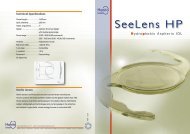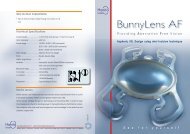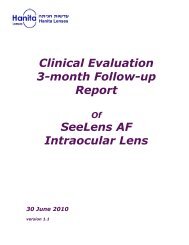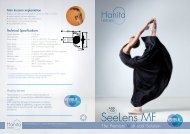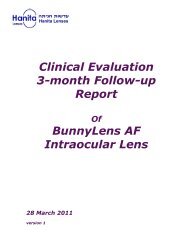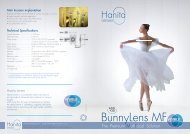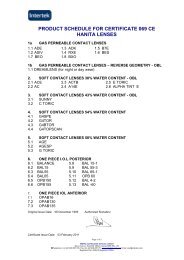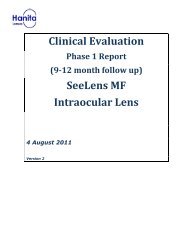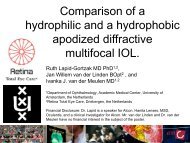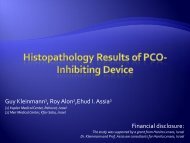Clinical Evaluation 1 to 3 months Follow Up Report SeeLens HP Intraocular Lens
SeeLens HP - Clinical Evaluation Report 11/03/2012 - Hanita Lenses
SeeLens HP - Clinical Evaluation Report 11/03/2012 - Hanita Lenses
- No tags were found...
You also want an ePaper? Increase the reach of your titles
YUMPU automatically turns print PDFs into web optimized ePapers that Google loves.
Page 2 of 11Ver. 11 ObjectivesThe objective of this study is <strong>to</strong> evaluate the safety and efficacy of the <strong>See<strong>Lens</strong></strong> <strong>HP</strong> IOL,implanted following cataract removal by phacoemulsification.a. The key efficacy parameters are:- Best Corrected Visual Acuity (BCVA)- Predictability of refraction.b. The key safety parameters include:- IOL performance during implantation and follow-up.- IOL related infection and/or inflamma<strong>to</strong>ry reactions.2 Efficacy and Safety AssessmentsThe efficacy and safety assessments were determined as defined by and according <strong>to</strong> the ISO11979 directive. The following are the demands required by the directive:1. Post Operative BCVA of at least 6/12 (20/40) within 88% of patients' population. For the"best cases" patients, BCVA 6/12 (20/40) or better, for at least 94% of the patients.(Requirements defined by ISO 11979-7 2001).2. IOL related Post Operative complication and Adverse Events equal <strong>to</strong> or less then theallowed rate defined by ISO 11979-7 2001.3. Refraction deviations criteria were established according <strong>to</strong> literature. The standard foraccuracy for normal eyes was addressed in study "Benchmark standards for refractiveoutcomes after NHS cataract surgery." The authors concluded that the "benchmark"standard for refractive outcomes for normal eyes after cataract surgery should be within±0.50 D for 55% of cases and within ±1.00 D for 85% of cases (Gale RP, Saldana M,Johns<strong>to</strong>n RL, Zuberbuhler B, McKibbin M. Benchmark standards for refractive outcomesafter NHS cataract surgery. Published on-line in Eye, 24 August 2007)3 Medical Device Specification and Administration3.1 Specifications3.1.1 Device description<strong>See<strong>Lens</strong></strong> <strong>HP</strong> is a single-piece hydrophobic acrylic, aspheric, posterior chamber intraocularlens. The <strong>See<strong>Lens</strong></strong> <strong>HP</strong> is CE marked since 2009 and being sold in many countriesworldwide. <strong>See<strong>Lens</strong></strong> <strong>HP</strong> is an important member in the <strong>See<strong>Lens</strong></strong> family which is knownfor its leading design, safety, stability and vision predictability.The <strong>See<strong>Lens</strong></strong> <strong>HP</strong> is made of hydrophobic acrylic material, which is known <strong>to</strong> be superiorin postponing the posterior capsular opacification (PCO).Hanita <strong>Lens</strong>es <strong>Intraocular</strong> & Contact <strong>Lens</strong>esעדשות חניתהעדשות מגע ועדשות השתלה תוך-עינית•קיבוץ חניתה • 88222 www.hanitalenses.com Kibbutz Hanita 22885 Israel • Tel. 972-4-9950 700• Fax: 972-4-9950 755 •



